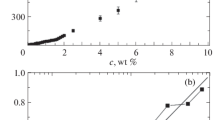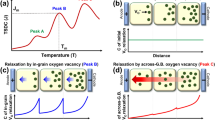Abstract
The discharging process of polyvinyl pyrrolidone electret under two different heating rates 3.5 and 2 °C/min has been investigated by the measurement of thermally stimulated depolarization current (TSDC) in the temperature range from 30 to 250 °C. The TSDC spectra of PVP shows three peaks located at 70 ± 10, 150 ± 10, and 230 ± 10 °C, respectively. When explaining the TSDC spectra, this thesis deduced that the first peak, β peak, originates from side group relaxation; the second peak, α peak, corresponds to the relaxation of the frozen dipoles on the molecule chain segments during glass transition; the third peak, ρ peak, is attributed to the detrapping of the trapped space charge under thermal stimulation. The current of the ρ peak is remarkably strong due to the fact that PVP molecules’ side groups—the pyrrolidone rings containing lactam structure—are strong polar groups which cause the great increase in the number of bulk traps, trapped space charge, as well as detrapped space charge under thermal stimulation.





Similar content being viewed by others
References
Sessler GM (1987) Electrets, 2nd edn, Chap 3. Springer-Verlag, Berlin
Bräunlich P (1979) Thermally stimulated relaxation in solids, Chap 5. Springer-Verlag, Berlin
Narsimha Rao VVR, Kalpalatha A (1987) Electrical conduction mechanism in poly(vinyl pyrrolidone) films. Polymer 28:648
Khare PK, Shrivastava S, Srivastava AP (1994) Indian J Phys A68:129
Khare PK, Chandok RS (1995) Indian J Phys A69:545
De Queiroz AAA, Soares DAW (2001) Resistive-type humidity sensors based on PVP–Co and PVP–I2 complexes. J Polym Sci B 39:459–469
Lakshminarayana K, Narasimha Rao VVR (1997) Pyroelectric behaviour of polyvinyl alcohol (PVA)-polyvinylpyrrolidone (PVP) polymer blend films. Mater Lett 30:65
Reddy R, Chang LQ, Luthra S (2009) The glass transition and sub-T(g)-relaxation in pharmaceutical powders and dried proteins by thermally stimulated current. J Pharm Sci 98(1):81–93
Narasimha Rao VVR, Kalpalatha A (1987) Thermally stimulated discharge currents in polyvinyl pyrrolidone polymer films. Mater Chem Phys 17(4):317
Khare PK, Jain SK (2000) Anomalous thermally stimulated currents and space charge in poly(vinyl pyrrolidone). Polym Int 49:265–268
Khare PK, Jain SK (1997) Thermally stimulated currents in polyvinyl pyrrolidone: polymethyl methacrylate polyblend films. J Polym Mater 14(1):65–69
Khare PK, Verma A, Sahu DK, Srivastava RK (2003) The evaluation of dielectric properties of pure polyvinylpyrrolidone films. Indian J Phys 77a(5):453–457
Khare PK, Keller JM, Datt SC (1992) Thermally stimulated depolarization currents in sensitized polyvinyl pyrrolidone films. Indian J Pure Appl Phys 30(12):768–770
Mudarra M, Belana J (1997) Study of poly (methyl methacrylate) space charge relaxation by TSDC. Polymer 38:5815–5821
Xia ZF (2001) Electret. Science Press, Beijing
Chen R (1981) Analysis of thermally stimulated process. Pergamen Press, Oxford
Peng Z (2000) TSC study of polyvinylidene fluoride (PVDF) and its copolymers. PhD Thesis of USTC, Hefei (in Chinese)
Bucci C, Fieschi R (1964) Ionic thermoconductivity. Method for the investigation of polarization in insulators. Phys Rev Lett 12:16
Simmons JG, Taylor GW (1972) High-field isothermal currents and thermally stimulated currents in insulators having discrete trapping levels. Phys Rev App 5:1619–1628
Sedita JS, O’Reilly JM (2001) A thermally stimulated depolarization current study of polymers in the glass transition region. Polym Eng Sci 41(1):5–22
Seanor DA (1982) Electrical properties of polymer. Academic Press, New York
Acknowledgments
Financial support from the National Natural Science Foundation of China (No. 20974108) is acknowledged.
Author information
Authors and Affiliations
Corresponding author
Rights and permissions
About this article
Cite this article
Shi, Y., Zhang, XY. & Gong, LL. Molecular motion and detrapping behavior of trapped space charges in polyvinyl pyrrolidone: a thermally stimulated depolarization current study. Polym. Bull. 67, 1595–1604 (2011). https://doi.org/10.1007/s00289-011-0504-1
Received:
Revised:
Accepted:
Published:
Issue Date:
DOI: https://doi.org/10.1007/s00289-011-0504-1




